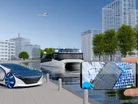Chalmers' Battery Powers Lighter, Efficient Vehicles

A groundbreaking innovation in battery technology is poised to transform the transportation and electronics industries.
Researchers at Chalmers University of Technology in Sweden have developed a "structural battery" — a material that functions both as a battery and a load-bearing structure.
This dual-function capability dramatically reduces the weight and energy consumption of vehicles, electronics and other devices.
The result? Lighter, more energy-efficient cars, planes and even computers.
The cutting-edge technology represents a major step toward sustainable energy use and could transform industries as diverse as automotive, aerospace and consumer electronics.
A battery with multiple functions
Imagine a battery that powers a device and is part of its structure. The research team at Chalmers has achieved this exactly.
Richa Chaudhary, a lead researcher on the project, explains:
"We've succeeded in creating a carbon fibre composite battery that is as stiff as aluminium and energy-dense enough for commercial applications."
Much like the human skeleton, the structural battery performs multiple functions simultaneously. Integrating energy storage directly into the vehicle or device's framework eliminates the need for heavy, separate battery packs, slashing the overall weight. The result is a significant reduction in energy consumption. For instance, an electric car equipped with these batteries could see its driving range increase by up to 70% on a single charge, all thanks to the reduced weight.
The evolution of structural batteries
The idea of a structural battery was introduced previously.
In fact, research at Chalmers has been ongoing for several years.
In 2018, the team made headlines by demonstrating how strong, stiff carbon fibres could store electrical energy chemically.
Physics World hailed the breakthrough as one of the top 10 achievements of the year.
Fast-forward to today and the Chalmers team has improved both the energy density and stiffness of their structural battery.
The latest model has an energy density of 30 watt-hours per kilogram (Wh/kg), a significant jump from the 24 Wh/kg they achieved in 2021.
While this is still less than current lithium-ion batteries, the game-changing potential lies in the weight savings. The material used in these batteries can now carry loads as effectively as aluminium but at a much lighter weight.
Transforming EV market
One of the most promising applications for structural batteries is in the automotive industry.
With EVs already gaining momentum, reducing the weight of the car's battery is crucial for increasing driving range and lowering energy consumption.
Professor Leif Asp, the research leader at Chalmers University, states:
"Investing in lightweight, energy-efficient vehicles is essential for conserving energy and safeguarding future generations."
The team's structural battery has significantly increased its stiffness, meeting automotive use safety and strength requirements.
This makes it an ideal candidate for integration into electric cars, which, if equipped with competitive structural batteries, could drive up to 70% farther than today's models.
Commercialisation
Despite these impressive advancements, the journey toward commercialisation is ongoing.
A recently launched venture, Sinonus AB, is working to bring the technology to market. However, many challenges remain, including scaling production and refining the technology for mass use.
The most immediate applications could be in consumer electronics.
Credit card-thin mobile phones and laptops weighing half as much as today's models are on the horizon. Meanwhile, automotive and aerospace companies show great interest in using structural batteries to power components in vehicles and aircraft.
The potential of structural batteries extends far beyond just cars and gadgets. Structural batteries can become integral to the construction materials of a wide range of products, drastically reducing weight while improving energy efficiency. Drones, handheld tools and even aeroplanes could benefit from this breakthrough.
Published in Advanced Materials, this research highlights the Chalmers team's significant advancements.
The battery comprises carbon fibre, serving as positive and negative electrodes.
Unlike conventional lithium-ion batteries, no copper or aluminium is required for the current collectors, further reducing the weight.
The absence of conflict metals like cobalt and manganese makes the battery more sustainable.
The road ahead
While the structural battery is still in the research phase, its potential is undeniable.
The Wallenberg Initiative Materials Science for Sustainability (WISE) program has provided funding. Ongoing research will focus on improving power output and ensuring the battery can meet the demands of real-world applications.
The future of energy-efficient vehicles and electronics is closer than ever. With further development, the breakthrough could reshape how we power everything from EVs to mobile phones, creating a lighter, greener world.
Make sure you check out the latest edition of EV Magazine and also sign up to our global conference series - Sustainability LIVE 2024.
EV Magazine is a BizClik brand.


